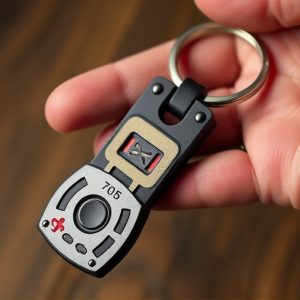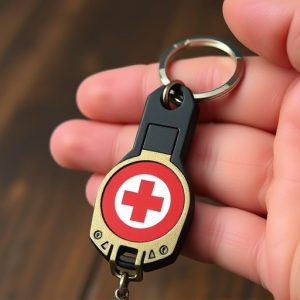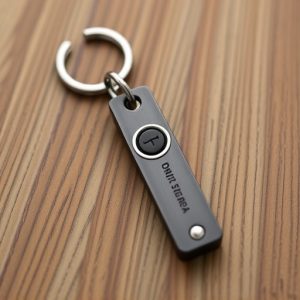Protective Keychain Defense: Legal Tips & Design Guide for Self-Safety
Before considering a keychain weapon for self-defense, thoroughly research local Keychain Weapon Per…….
Before considering a keychain weapon for self-defense, thoroughly research local Keychain Weapon Permit Requirements which vary significantly by region. Design or choose one made of durable materials like steel or aluminum, with reliable locking mechanisms and easy accessibility, adhering to permit conditions regarding size, weight, and legality. Prioritize responsible usage, storage, and awareness of surroundings, along with meeting legal criteria including background checks and training, to ensure safety and effectiveness as a self-defense tool.
In today’s world, personal safety is paramount. For those seeking an accessible self-defense option, protective keychains with blunt force capabilities offer a discreet yet powerful tool. This comprehensive guide delves into the legalities and permits surrounding keychain weapons, explores design considerations for effective protection, highlights essential features, and provides insights on carrying and using your keychain weapon safely within legal parameters. Understanding the keychain weapon permit requirements is crucial before harnessing this innovative self-defense solution.
- Understanding Keychain Weapon Legalities and Permits
- Designing a Protective Keychain with Blunt Force Capabilities
- Essential Features for Self-Defense Keychains
- Unlocking the Potential: Carrying and Using Your Keychain Weapon Legally and Safely
Understanding Keychain Weapon Legalities and Permits
In many regions, carrying a keychain weapon, especially one designed for self-defense against blunt force trauma, is subject to specific laws and regulations. Understanding these legalities and permit requirements is crucial before considering such a purchase. Keychain weapon permit requirements vary widely depending on your location, with some areas allowing them without a permit and others mandating strict licensing or even outright prohibition.
To navigate this, research your local and state laws thoroughly. Check for any specific restrictions on self-defense tools, as well as the types of weapons that are permitted. Some regions might classify keychain weapons differently, leading to varying permit conditions. Staying informed about these details ensures you remain compliant while protecting yourself effectively.
Designing a Protective Keychain with Blunt Force Capabilities
When designing a protective keychain with blunt force capabilities, it’s crucial to balance functionality and safety. The keychain should be easily accessible yet secure, ensuring it can protect against potential threats while adhering to relevant legal requirements, such as those governing keychain weapon permit regulations. Key considerations include choosing appropriate materials that are durable yet non-lethal, integrating reliable locking mechanisms, and designing a comfortable grip for easy handling in stressful situations.
The design process should also account for the intended use cases. For example, the keychain may need to be able to break through windows or disable an attacker’s grip on a victim. This necessitates selecting impact-resistant materials and optimizing the shape and weight distribution for maximum force projection without causing unnecessary harm. Remember, the ultimate goal is to provide a functional self-defense tool while complying with legal guidelines governing keychain weapon permit requirements.
Essential Features for Self-Defense Keychains
When considering a keychain for self-defense, several essential features come into play. One of the primary concerns is the level of protection it offers. Look for keychains equipped with reliable and durable materials that can withstand impact, such as high-quality steel or aluminum. These materials ensure that the keychain can take a hit without compromising its structural integrity, providing you with a crucial advantage in a dangerous situation.
Additionally, consider the versatility and convenience of the design. A good self-defense keychain should seamlessly integrate with your keys and everyday carry items while remaining easily accessible. Look for models featuring innovative attachment mechanisms, like adjustable lanyards or secure clip systems, allowing you to wear it comfortably around your neck, wrist, or even attached to your backpack. Meeting the keychain weapon permit requirements, such as size, weight, and legal restrictions in your region, is also vital to ensure its practicality and legality.
Unlocking the Potential: Carrying and Using Your Keychain Weapon Legally and Safely
Carrying a keychain weapon, while an innovative concept for self-defense, comes with its own set of responsibilities and legal considerations. Unlocking its potential involves understanding the keychain weapon permit requirements in your region. Each jurisdiction has specific rules regarding concealed carry permits, including any restrictions on small arms or self-defense tools. Before wielding your protection keychain, ensure you meet all the necessary legal criteria. This may include background checks, training courses, and proof of proficiency with the device.
Legal compliance is not just about staying out of trouble; it’s also about ensuring personal safety. Using a keychain weapon responsibly means knowing local laws to avoid any accidental or intentional misuse. Responsible carry includes keeping the device secure when not in use, storing it safely at home, and being mindful of your surroundings. By adhering to legal requirements and practicing safe habits, you can fully realize the potential of your protection keychain as a legitimate self-defense tool.
In conclusion, a protection keychain with blunt force tips can be a valuable tool for personal safety when used legally and responsibly. Understanding local laws regarding keychain weapons and obtaining the necessary permits is essential. By incorporating robust design elements and prioritizing user safety, individuals can harness the potential of these compact self-defense tools while navigating complex legalities. Remember, proper training and adherence to regulations are key to ensuring your peace of mind and the safe use of your protection keychain.


